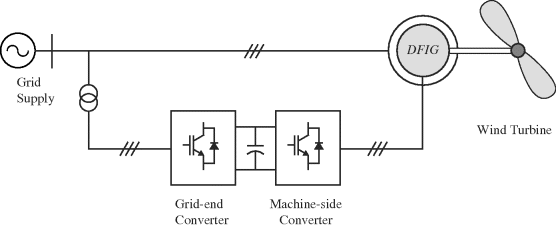4.3 Vector Control of Double Fed Induction Generator (DFIG)
4.3.1 Introduction
The DFIG is a rotor-wound three-phase induction machine that is connected to the AC supply from both stator and rotor terminals (Figure 4.17). The stator windings of the machine are connected to the utility grid without using power converters, and the rotor windings are fed by an active front-end converter. The machine can be fed by current or voltage source inverters with controlled voltage magnitude and frequency [12, 25–32].
Figure 4.17 General view of DFIG connected to wind system and utility grid

In the control schemes of DFIM, two output variables in the stator side are generally defined and used for the control. These defined variables could be electromagnetic torque and reactive power, active and reactive powers, or stator voltage and its frequency. Different structures are used to control each pair of such variables.
The DFIM is popular and widely adopted for high power wind generation systems and other types of generators with similar variable speed high power sources (e.g. hydro systems). The advantage of using this type of machine is that the required converter capacity is much lower (up to three times lower) than those that connect the converter to the stator side [12, 25–27, 32]. Hence, the costs and losses in the conversion system are drastically reduced [1].
DFIG can be used either in ...
Get High Performance Control of AC Drives with Matlab / Simulink Models now with the O’Reilly learning platform.
O’Reilly members experience books, live events, courses curated by job role, and more from O’Reilly and nearly 200 top publishers.

